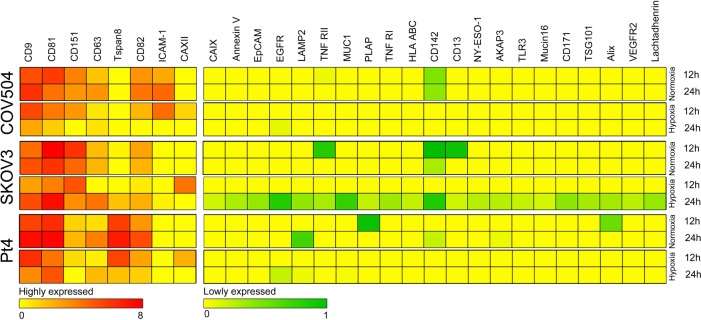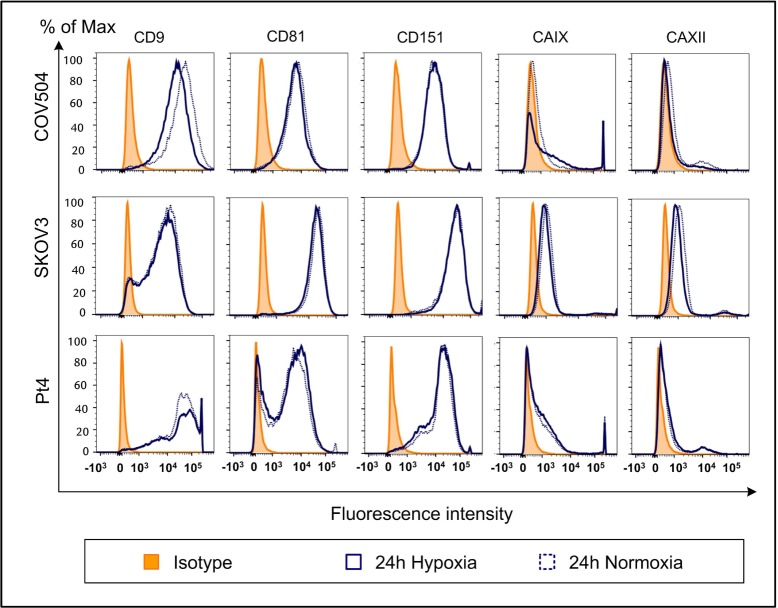Oxygen-Related Differences in Cellular and Vesicular Phenotypes Observed for Ovarian Cell Cancer Lines.
Q3 Medicine
Journal of Circulating Biomarkers
Pub Date : 2016-01-22
eCollection Date: 2016-01-01
DOI:10.5772/62219
引用次数: 4
Abstract
Extracellular vesicles (EVs) are one of several tools that cells use to communicate with each other. This communication is facilitated by a number of surface-associated proteins and the cargo of the vesicles. For several cancer types, the amount of EVs is observed to be up-regulated in patients compared to healthy individuals, possibly signifying the presence of an aberrant process. The hypoxia-induced release of EVs from cancer cells has been hypothesized to cause the malignant transformation of healthy recipient cells. In this study, the phenotype of cells and EVs from the ovarian cancer cell lines, COV504, SKOV3, and Pt4, were quantified and analysed under normoxic and hypoxic conditions. It was shown that both cells and EVs express common markers and that the EV phenotype varies more than the cellular phenotype. Additionally, cells subjected to 24 hours of hypoxia compared to normoxia produced more EVs. The phenotyping of EVs from cancer cell lines provides information about their molecular composition. This information may be translated to knowledge regarding the functionality of EVs and lead to a better understanding of their role in cancer.



卵巢癌细胞系细胞和水泡表型的氧相关差异
细胞外囊泡(EVs)是细胞相互沟通的几种工具之一。这种交流是由许多表面相关蛋白和囊泡的货物促进的。对于几种癌症类型,与健康个体相比,观察到患者中EVs的数量上调,可能表明存在异常过程。缺氧诱导的ev从癌细胞中释放,已经被假设导致健康受体细胞的恶性转化。本研究对卵巢癌细胞系COV504、SKOV3和Pt4在常氧和缺氧条件下的细胞和ev的表型进行了定量分析。结果表明,细胞和EV表达共同的标记,EV表型比细胞表型变化更大。此外,与正常缺氧相比,24小时缺氧的细胞产生了更多的ev。来自癌细胞系的ev表型提供了有关其分子组成的信息。这些信息可能转化为关于ev功能的知识,并导致更好地了解它们在癌症中的作用。
本文章由计算机程序翻译,如有差异,请以英文原文为准。
求助全文
约1分钟内获得全文
求助全文
来源期刊

Journal of Circulating Biomarkers
Medicine-Biochemistry (medical)
CiteScore
3.20
自引率
0.00%
发文量
9
审稿时长
8 weeks
期刊介绍:
Journal of Circulating Biomarkers is an international, peer-reviewed, open access scientific journal focusing on all aspects of the rapidly growing field of circulating blood-based biomarkers and diagnostics using circulating protein and lipid markers, circulating tumor cells (CTC), circulating cell-free DNA (cfDNA) and extracellular vesicles, including exosomes, microvesicles, microparticles, ectosomes and apoptotic bodies. The journal publishes high-impact articles that deal with all fields related to circulating biomarkers and diagnostics, ranging from basic science to translational and clinical applications. Papers from a wide variety of disciplines are welcome; interdisciplinary studies are especially suitable for this journal. Included within the scope are a broad array of specialties including (but not limited to) cancer, immunology, neurology, metabolic diseases, cardiovascular medicine, regenerative medicine, nosology, physiology, pathology, technological applications in diagnostics, therapeutics, vaccine, drug delivery, regenerative medicine, drug development and clinical trials. The journal also hosts reviews, perspectives and news on specific topics.
 求助内容:
求助内容: 应助结果提醒方式:
应助结果提醒方式:


